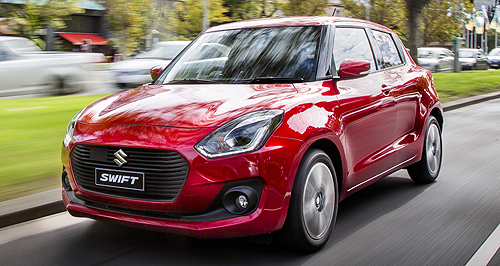Driven: Suzuki’s vital new Swift touches down
BY TUNG NGUYEN | 7th Jun 2017

While the base $15,990 Swift GL manual is cheaper by $1000 than the $16,990 Baleno GL manual, prices for the flagship GLX Turbo variants across the two models match at $22,990.
Aside from the top-spec 82kW/160Nm GLX Turbo variants, both models also make use of different naturally aspirated four-cylinder engines – the Swift using a 66kW/120Nm 1.2-litre Dualjet and the Baleno employing a 68kW/130Nm 1.4-litre unit.
Speaking to GoAuto at the national launch of the new fifth-generation Swift, Suzuki product planning and training manager Joanna Montalto said style-conscious customers would opt for the new hatchback, whereas practical buyers would go for the Baleno.
“I still think Swift and Baleno will get different buyers,” she said. “You know you’ve got your traditional Swift buyers who will shop Swift for its styling and its pricing, but then I think Baleno will attract perhaps a slightly older buyer – either an older buyer or a buyer who is perhaps looking for something a bit more conservative.
“They will attract a different market. Swift’s going to get a lot younger buyers than Baleno.”Despite both models sharing Suzuki’s Heartect platform and the same sub-$25,000 light-car segment, Suzuki pitches its Baleno as a small car competitor with a 355 litre boot capacity, whereas the new Swift will swallow only 242L with the rear seats up and up to 556L with the pews stowed.
Dimensionally, both models also differ, with the smaller Swift measuring 3840mm long, 1735mm wide, 1495mm high and with a 2450mm wheelbase against the Baleno’s 3995mm length, 1745mm width, 1470mm height with a 2520mm wheelbase.
With the new Swift expected to account for around 600 sales a month, combined with the 250-300 monthly sales average of the Baleno, Suzuki hopes it can emerge as the most popular marque in the light-car segment.
“Obviously being in the same segment, customers are now going to have a choice between the new Swift and Baleno,” Ms Montalto said. “I could see more customers perhaps moving up into a Swift than a Baleno, but I still think Baleno will do relatively well in the segment given that its targeted towards a different customer.
“I think Baleno was good for us because we never really had a true competitor against the likes of the Corolla and Mazda3, and we never really had a small car as such.
“I think it filled the void for Suzuki, where we never really had a player in that small segment.”As previously mentioned, the new Japanese-sourced Swift line-up will kick off at $15,990 with the only three-pedal option in the range, the GL manual, powered by a 1.2-litre Dualjet naturally aspirated four-cylinder engine producing 66kW of power at 6000rpm and 120Nm of torque at 4400rpm.
Standard equipment on entry-level Swifts include electronically adjustable door mirrors, cruise control, a white dimple pattern insert for the dashboard, Bluetooth connectivity, speed limiter, 15-inch steel wheels, black-coloured A- and B-pillars, daytime running lights, and front, side and curtain airbags.
Moving up to the $17,990 GL Navigator will net buyers a continuously variable transmission (CVT) mated to the same 1.2-litre engine, while standard equipment rises to include 16-inch alloy wheels, front foglights, hill-start assist, reversing camera and a 7.0-inch touchscreen infotainment display with satellite navigation, Apple CarPlay and Android Auto functionality.
GL Navigator variants are also available with the Safety Pack for an additional $1000, which adds autonomous emergency braking, adaptive cruise control, lane departure warning and weaving alert, as well as an LCD information display nestled between the instrumentation.
Fuel economy in the 800kg GL manual variants is 4.6 litres per 100km and CO2 emissions logged at 106 grams per km, while the 900kg CVT-equipped versions are slightly thirstier and more pollutant at 4.8L/100km and 110g/km respectively.
The range-topping Swift, for now, will be the $22,990 GLX Turbo, powered by a turbocharged 1.0-litre three cylinder producing 82kW of power at 5500rpm and 160Nm of torque from 1500-4000rpm.
In addition to more performance, the GLX Turbo also gains a six-speed torque-converting automatic transmission, rear disc brakes, polished alloy wheels, automatic LED headlights with high beam assist, electronically folding mirrors, telescopic-adjustable steering wheel, pearl white interior inserts, keyless start and chrome door handles.
GLX Turbo variants tip the scales at 915kg and will return a fuel consumption figure of 5.1L/100km and CO2 emissions of 119g/km.
All variants can be optioned with one of six exterior colour choices, including a new Burning Red pearl metallic and Speedy Blue metallicAccording to Suzuki, GL manual variants are expected to account for about 10 per cent of sales, while the bulk of new Swifts sold will likely be in the GL Navigator grade (55 per cent base, 15 per cent with the Safety Pack) and the remaining 20 per cent accounted for with the GLX Turbo.
Suzuki’s new Swift will also be one of the most expensive competitors in the light-car segment, with the Holden Barina, Honda Jazz, Hyundai Accent and Mazda2 starting at $14,990 while the Ford Fiesta is priced at $15,825 and the Toyota Yaris carrying a $15,290 cost.
2017 Suzuki Swift pricing*
| GL | $15,990 |
| GL Navigator (a) | $17,990 |
| GL Navigator with Safety Pack (a) | $18,990 |
| GLX Turbo (a) | $22,990 |